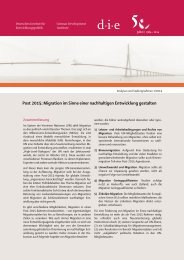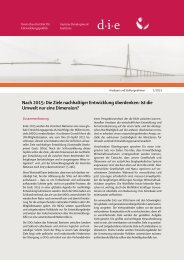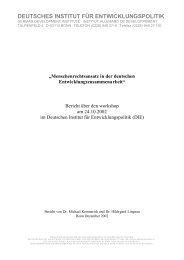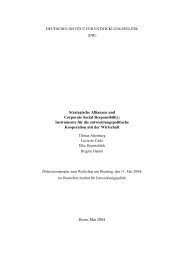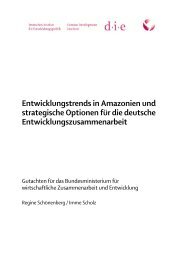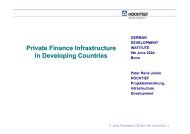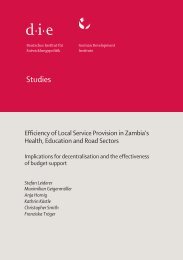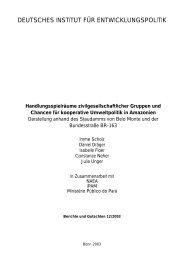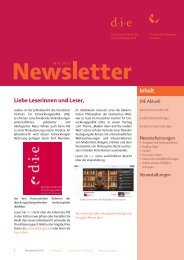Middle East / North Africa and the Millennium Development Goals ...
Middle East / North Africa and the Millennium Development Goals ...
Middle East / North Africa and the Millennium Development Goals ...
You also want an ePaper? Increase the reach of your titles
YUMPU automatically turns print PDFs into web optimized ePapers that Google loves.
3.7 Ensuring environmental sustainability (MDG7)<br />
80<br />
Markus Loewe<br />
MDG7 has three targets that are only very loosely interconnected <strong>and</strong> that<br />
may, in some areas, even result in goal conflicts. The focal point here is<br />
Target 9, i.e. to “integrate <strong>the</strong> principles of sustainable development into<br />
country policies <strong>and</strong> programs <strong>and</strong> reverse <strong>the</strong> loss of environmental resources.”<br />
Target 10 sets out to “halve, by 2015, <strong>the</strong> proportion of people<br />
without sustainable access to safe drinking water <strong>and</strong> sanitation.” Target<br />
11, finally, provides for efforts to achieve a significant improvement in<br />
<strong>the</strong> lives of at least 100 million slum dwellers worldwide.<br />
Environmental protection<br />
Target 9 is one of <strong>the</strong> few points on <strong>the</strong> MDG agenda that has not been<br />
quantified as such. In order to be able to measure progress in <strong>the</strong> implementation<br />
of <strong>the</strong> target, six indicators were chosen which were thought to<br />
be able to model <strong>the</strong> broadest possible spectrum of environmental policy.<br />
The first indicator – proportion of l<strong>and</strong> area covered by forests – is not particularly<br />
relevant for <strong>the</strong> countries of <strong>the</strong> MENA region. With <strong>the</strong> exceptions<br />
of Sudan, Morocco, <strong>and</strong> Lebanon, none of <strong>the</strong>se countries has had<br />
any major forest cover since <strong>the</strong> period of classical antiquity. Nor is it<br />
likely that <strong>the</strong> region’s forest cover will grow appreciably in <strong>the</strong> future.<br />
However, one alarming fact is that, according to World Bank data (World<br />
Bank 2004e), Sudan’s forest cover declined from 30 % to roughly 26 % of<br />
<strong>the</strong> country’s overall l<strong>and</strong> area between 1990 <strong>and</strong> 2001.<br />
On <strong>the</strong> o<strong>the</strong>r h<strong>and</strong>, <strong>the</strong> MDG agenda lacks an indicator designed to measure<br />
soil degradation. Soil degradation poses a major environmental threat<br />
precisely for <strong>the</strong> MENA countries, one that will entail serious problems for<br />
<strong>the</strong> region’s future social <strong>and</strong> economic development.<br />
However, <strong>the</strong> o<strong>the</strong>r five indicators included in <strong>the</strong> MDG agenda show that<br />
<strong>the</strong> MENA countries will have to undertake substantial efforts if <strong>the</strong>y are<br />
to implement MDG7 by 2015 (ESCWA 2005).<br />
The percentage of l<strong>and</strong> set aside as conservation areas in <strong>the</strong> MENA region<br />
has grown since 1990 from roughly 2 to over 10 %. The main reason<br />
for this, though, is that during <strong>the</strong> 1990s Saudi Arabia set aside 38 % of its<br />
l<strong>and</strong> area as a nature reserve. Only Oman <strong>and</strong> Saudi Arabia have placed<br />
more than 10 % of <strong>the</strong>ir l<strong>and</strong> area under protection (see Table A9, Annex).<br />
German <strong>Development</strong> Institute



